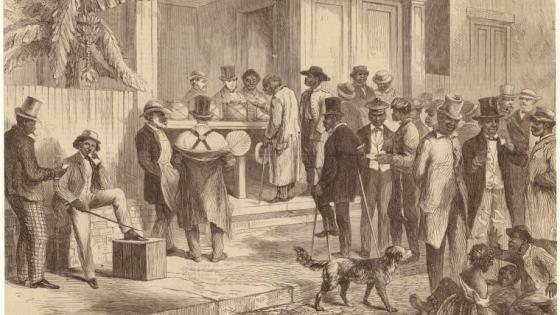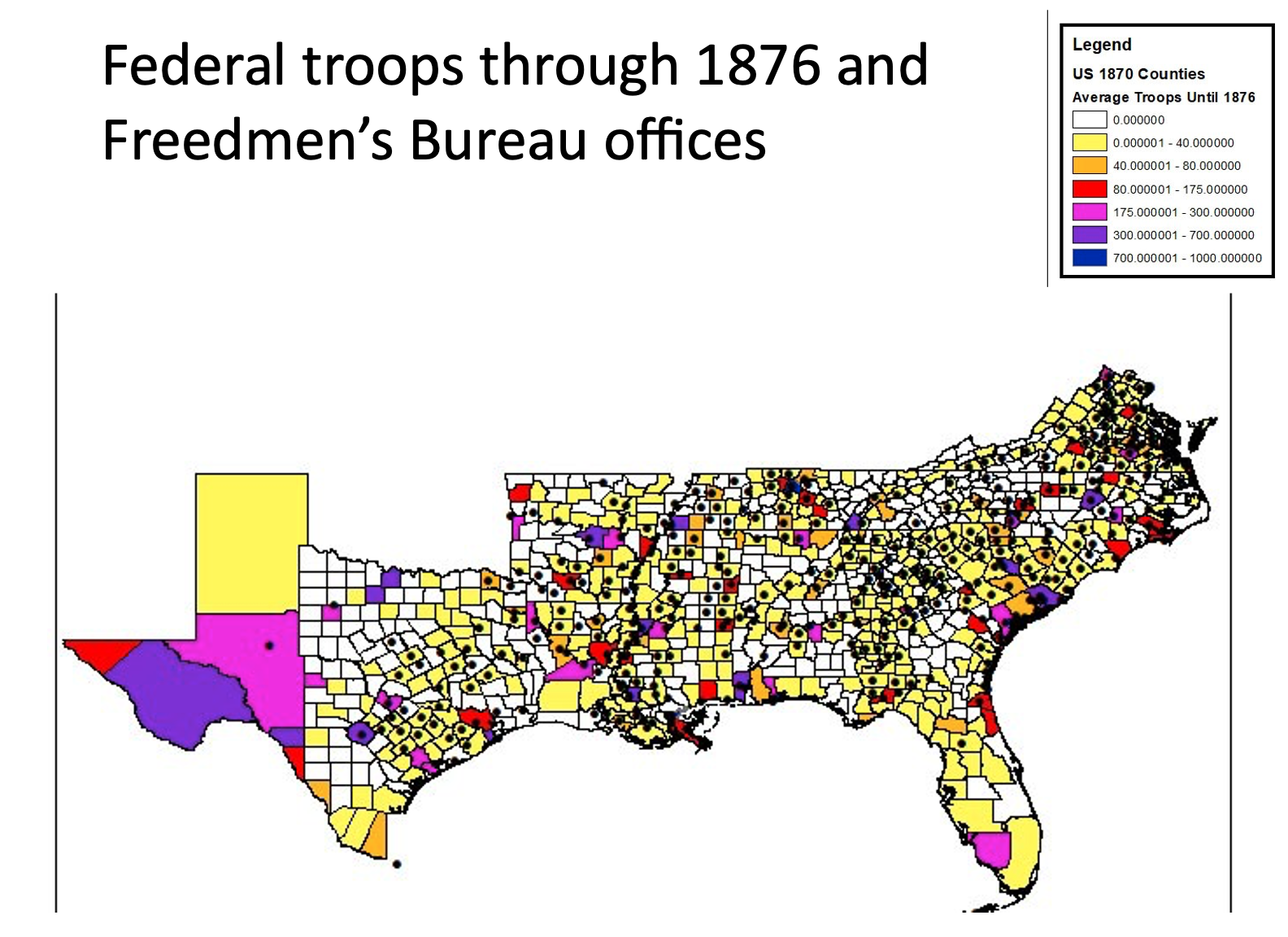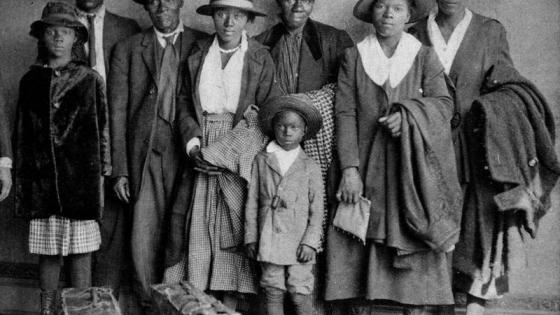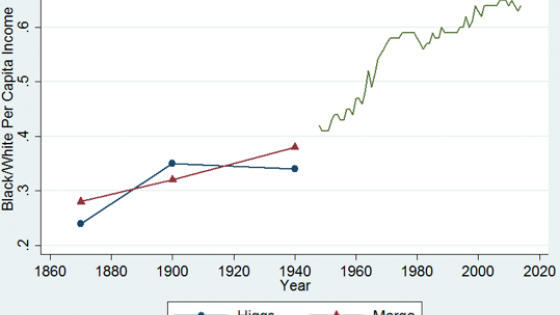One of the most prominent research agendas in political science and economics concerns the impact of institutions on comparative economic development. This literature can be traced back to the pioneering work of Nobel laureate Douglass North, including Davis and North (1971), North and Thomas (1973), North and Weingast (1989), and North (1990). These early studies laid the foundations for the seminal works of Sokoloff and Engerman (2000), who emphasise the impact of factor endowments on political and economic development, and Acemoglu and Robinson (2008), who contributed to our understanding of institutions by distinguishing between de jure and de facto political power.
In recent work (Frieden et al. 2024), we study how dramatic institutional change interacted with factor endowments in the American South during the Reconstruction era. In the aftermath of the Civil War, the victorious Union embarked on a massive social experiment. A million formerly enslaved adult men gained the right to vote, while many former Confederates were disenfranchised. Tens of thousands of federal troops occupied the former Confederacy, and nearly a thousand offices of the Freedmen’s Bureaus were set up across the region (Figure 1) to assist freed people in securing their political and legal rights, as well as to provide educational and social services. Eyewitness accounts suggest that this federal presence was important in securing the rights of the formerly enslaved. As one observer put it, “[t]he wrongs increase just in proportion to the distance from the US authorities” (White 2017: 69).
Figure 1 Federal troops until 1876 and Freedmen’s Bureau offices in post–Civil War US South
Black people, who made up a significant portion of the population of the South, took enthusiastic advantage of their new political and civil rights. The enfranchisement of freedmen in the former Confederacy led to the electoral dominance of the Republican Party, which was firmly committed to guaranteeing the legal and civil rights of freed people. This also resulted in the election of well over a thousand Black politicians, including many at the local and state level who were responsible for setting local policy and enforcing the law (Foner 1988). Freedmen’s Bureau offices helped to establish 4,300 schools that were educating 250,000 formerly enslaved children by 1870.
After the Hayes-Tilden agreement following the 1876 election, federal troops gradually returned to their barracks. Within a few decades, white supremacists reversed the political gains made by Black people and their white allies with a combination of extra-legal terror, legal manipulation, and fraud.
How did this massive political change affect the lives of Black people in the South? Did these major political reforms have an impact on the social and economic opportunities available to freed people? Did enfranchisement, political engagement, and civil rights – however transitory – lead to Black socioeconomic advances in the South? And did these changes, if any, persist after Reconstruction policies were largely reversed?
We use the location of federal troops and Freedmen’s Bureaus across Southern counties as an indicator of the intensity of Reconstruction, and the county’s cotton suitability as an indicator of the presence of an anti-Reconstruction planter elite. We then look at the political and socioeconomic outcomes for Black Americans in the former Confederacy to answer questions about the short- and longer-term consequences of Reconstruction.
We find that a greater federal presence during Reconstruction was associated with more Black political engagement, including higher Black voter registration, more votes for the Republican Party, and more Black office holders at the state and local levels. This effect was less pronounced in areas dominated by cotton plantations. Using data from the 1880 census, we find that areas that had a greater federal presence exhibited higher levels of school attendance by Black youths aged 6–16. We also find that the Black populations of these counties had higher literacy, average occupational status, and agricultural position – that is, a higher percentage in high-status/pay occupations (e.g. professions, managers, skilled craftsmen) and a lower percentage in low-status/pay occupations (e.g. farm labour). This effect, too, was less pronounced in cotton plantation regions.
We then use data from the 1900 and 1910 censuses to see if these effects were persistent. Again, we find that in counties where there had been a greater federal presence during Reconstruction, Black citizens were more likely to have higher-skilled/paid occupations, were more likely to be home and farm owners, and less likely to be share tenants nearly a quarter of a century after the end of Reconstruction. And, yet again, these effects are lessened in cotton plantation areas.
We further assess the mechanism that might have been at play in explaining our results. We find that greater Republican majorities and more Black local office holders in a county in the1870s led to higher local property tax rates – an effect that was reduced in cotton plantation areas. Previous work has shown that the election of Black politicians was associated with higher tax revenues and higher Black literacy rates and land tenancy (Logan 2020, Suryanarayan and White 2021). We believe that higher tax rates led to greater investment in local education during the Reconstruction period, and indeed they were associated with a higher proportion of Black children attending school. This investment led to long-term benefits for the formerly enslaved. Despite the concerted – and, ultimately, successful – effort by white supremacists to disenfranchise Blacks through all manner of legal and extra-legal tactics, the educational gains made during Reconstruction were less reversible and, as a consequence, had a lasting positive on Black socioeconomic achievement.
Our findings strongly suggest that the major institutional changes put in place during Reconstruction had many of the positive effects intended by their architects. Reconstruction facilitated, for a time at least, Black political empowerment. Combined with a strong federal presence, political empowerment had important and lasting socioeconomic effects. Black people and their allies in the former Confederacy were able to massively expand Black children’s access to education and to facilitate access to occupational and professional opportunities from which they had previously been excluded. Although white supremacists eventually reversed the enfranchisement of most Black men, the socioeconomic impact of the advances achieved during and after Reconstruction endured for decades.
The evidence presented here is very strongly in line with the proposition that political-institutional reforms to expand the franchise, especially to disadvantaged segments of the population, lead to improvements in the lot of those newly empowered. An important implication of the Reconstruction experience, however, is that formal institutional change is not enough to ensure long-term institutional change. At one level this is obvious, since the franchise was eventually stolen back by white supremacists. More to the point, the presence of federal troops and the Freedmen’s Bureau had a powerful impact on political and socioeconomic outcomes; it took the power of the state to enforce the rights enumerated by formal legal changes. This suggests an important amendment, even corrective, to a simple – perhaps naïve – focus on institutions and institutional change as in and of themselves catalysts of political and socioeconomic change. In the Reconstruction context, institutional reform required the support of military might and dedicated government officials.
Another important corrective to the purely institutional view is that the underlying economic structure of the region affected the impact of the institutional changes. Counties in the cotton plantation zone lagged well behind the rest of the South, so much so that in some of our analyses being in a cotton region negated the impact of Black political engagement and federal presence. This is consistent with much of the secondary literature, which typically characterises cotton plantations as enclaves within which the planter elite could exercise major pressure on Black workers and could often manipulate local institutions to produce desired political results almost at will. The production structure affected social and political power and could in some instances overcome institutional change.
Reconstruction and the federal presence had direct, important, and long-lasting positive effects on a whole range of Black socioeconomic outcomes, including schooling, literacy, occupational status, and property ownership. The evidence we present demonstrates the profound and lasting impact that changes in political institutions can have on both political and socioeconomic outcomes. However, it also suggests some cautionary notes. First, it makes clear that changing institutions – laws and rules – is not sufficient to overcome historical disadvantages and entrenched opposition. In the case of Reconstruction, it took the organised power of the state – including military power, in ways that mattered at the very local level – to make meaningful and lasting change possible. Second, it makes clear that the underlying economic structure of an area can have a powerful impact on its susceptibility to reform. More specifically, the effects of political-institutional change can be stymied or blocked by entrenched interests, such as the cotton planter elite represented in the South. We believe that all these lessons remain relevant and are of profound interest and value, today.
References
Acemoglu, D, and J A Robinson (2008), “Persistence of power, elites, and institutions”, American Economic Review 98(1): 267–93.
Davis, L E, and D C North (1971), Institutional change and American economic growth, Cambridge and New York: Cambridge University Press.
Foner, E (1988), Reconstruction: America’s unfinished revolution 1863–1877, New York: Harper and Row.
Frieden, J, R Grossman, and D Lowery (2024), “Was Freedom Road a dead end? Political and socio-economic effects of Reconstruction in the American South”, CEPR Discussion Paper 18844.
Logan, T (2020), “Do Black politicians matter? Evidence from Reconstruction”, Journal of Economic History 80(1): 1–37.
North, D C, and R P Thomas (1973), The rise of the Western world: A new economic history, Cambridge: Cambridge University Press.
North, D C (1990), Institutions, institutional change and economic performance, New York: Cambridge University Press.
North, D C, and B R Weingast (1989), “Constitutions and commitment: The evolution of institutions governing public choice in seventeenth-century England”, Journal of Economic History 49(4): 803–32.
Sokoloff, K L, and S L Engerman (2000), “Institutions, factor endowments, and paths of development in the New World”, Journal of Economic Perspectives 14(3): 217–32.
Suryanarayan, P, and S White (2021), “Slavery, Reconstruction, and bureaucratic capacity in the American South”, American Political Science Review 115(2): 568–84.
White, R (2017), The Republic for which it stands, New York: Oxford University Press.







